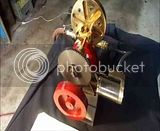jwcnc1911
-jwcnc191
- Joined
- Mar 19, 2013
- Messages
- 603
- Reaction score
- 86
I don't think so. If you look at the typical crossed universal joint, when it's at an angle, it accelerates and decelerates twice in each revolution.
The axes are parallel, not at an angle like a UV joint. Surface speed, or as most machinist refer to it, surface footage, is a linear conversion of rotational speed based on circumference. Most tooling manufacturers will provide you with a recommended SFM as a starting point for feed/speed calculations.
Check out that PDF I put a couple posts up for formulas.









